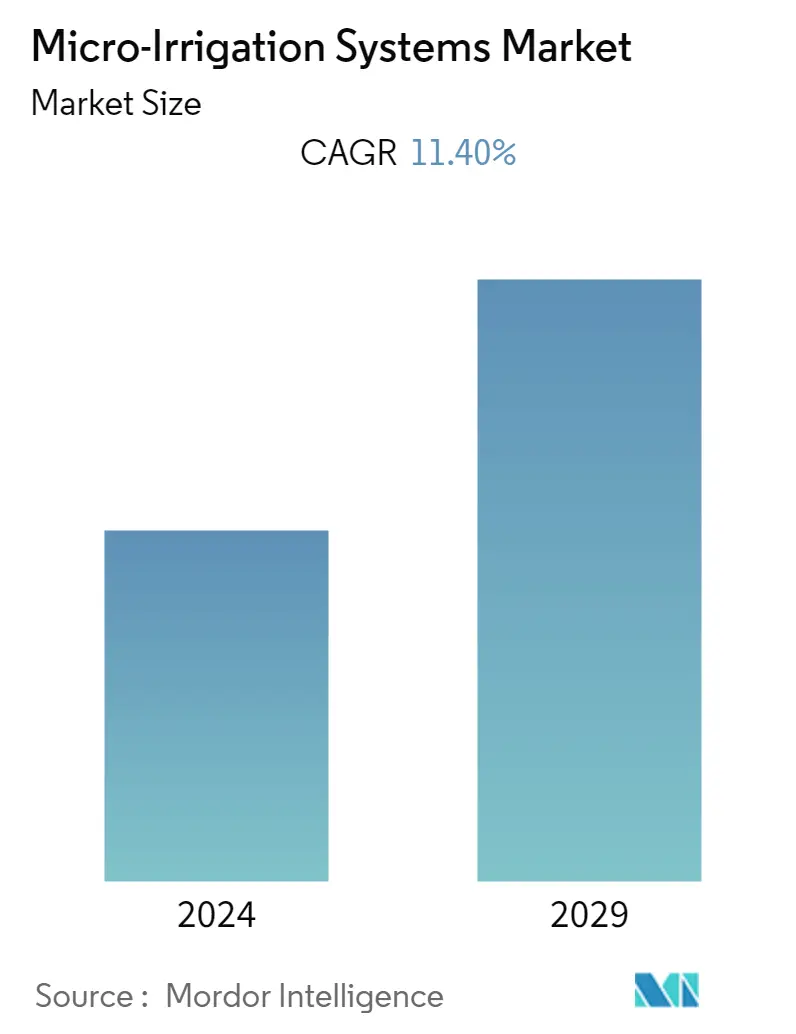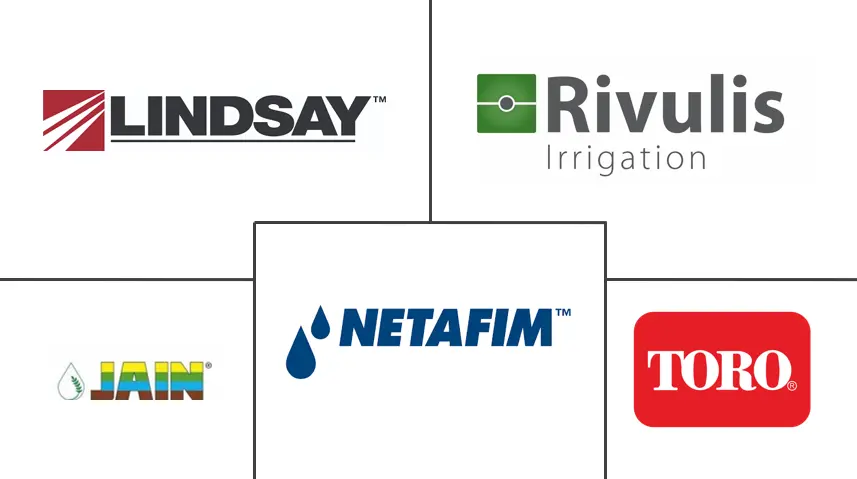Market Size of Micro-Irrigation Systems Industry

| Study Period | 2019 - 2029 |
| Base Year For Estimation | 2023 |
| CAGR | 11.40 % |
| Fastest Growing Market | Asia Pacific |
| Largest Market | Asia Pacific |
| Market Concentration | High |
Major Players
*Disclaimer: Major Players sorted in no particular order |
Micro Irrigation System Market Analysis
The micro-irrigation systems market is projected to register a CAGR of 11.4% during the forecast period.
- Micro-irrigation technologies are among the most effective systems farmers use in many developed economies to reduce water wastage. For instance, a major company such as Netafim Ltd offers drip irrigation systems that can be embedded in pipes to simplify the installation process while creating sustainable agricultural production and improving the livelihood and economic position of millions of smallholder farmers.
- Automatic drip irrigation is essential for controlling soil moisture, especially for specialized greenhouse vegetables. Total automation of drip irrigation systems provides a simple, meticulous method for controlling soil moisture and applying water. Effective time management, elimination of human errors in terms of estimation, and adjustment of available soil moisture levels are some of the factors augmenting the demand for automatic drip irrigation systems.
- Many countries are focused on developing micro irrigation because of water scarcity and demand for water to improve agricultural productivity. For instance, the National Bank for Agriculture and Rural Development (NABARD) in India allocated USD 100 billion to develop micro-sprinkler irrigation. The government has set a target of covering 100 lakh hectares for micro-irrigation within the next five years.
- The government of Colorado declared a serious water crisis in the south basin of the Colorado River in 2022. Ms. Kyrsten Sinema, Colorado's agricultural minister, announced a USD 4 billion compensation to help alleviate the adverse effects of the drought on the Colorado River. These funds were granted for renovating the dams of the river, its infrastructural development, and adequate water usage using drip irrigation.
- Factors such as an increase in water scarcity and rapid growth in greenhouse vegetable production are expected to be major drivers of micro irrigation. Furthermore, these systems are expected to increase profits generated per yield.
Micro Irrigation System Industry Segmentation
Micro irrigation is a modern method involving water and nutrients controlled application using drippers, sprinklers, and foggers. This irrigation technology is suitable for a wide range of crops since it improves water intake efficiency while reducing fertilizer loss and soil erosion.
The micro-irrigation systems market is segmented by mechanism (drip irrigation systems, sprinkler irrigation systems, and other micro-irrigation systems), component (drip irrigation components and sprinkler irrigation components), cultivation technology (open field and protected cultivation), application (field crops, orchards and vineyards, vegetables, plantation crops, and other applications), and geography (North America, Europe, Asia Pacific, South America, and Africa).
The report offers market size and forecasts for the micro-irrigation systems market in value (USD million) for all the above segments.
| By Mechanism | |
| Drip Irrigation System | |
| Sprinkler Irrigation System | |
| Other Micro-irrigation Systems |
| By Component | |||||||
| |||||||
|
| By Cultivation Technology | |
| Open Field | |
| Protected Cultivation |
| By Application | |
| Field Crops | |
| Orchards and Vineyards | |
| Vegetables | |
| Plantation Crops | |
| Other Applications |
| By Geography | |||||||||
| |||||||||
| |||||||||
| |||||||||
| |||||||||
|
Micro-Irrigation Systems Market Size Summary
The micro-irrigation systems market is experiencing significant growth, driven by the increasing need to enhance agricultural productivity while addressing water scarcity issues. These systems, including drip and sprinkler irrigation, are becoming essential in developed economies for their efficiency in reducing water wastage. Companies like Netafim Ltd are leading the way in providing advanced solutions that integrate seamlessly into agricultural practices, improving the economic conditions of smallholder farmers. The demand for automatic drip irrigation systems is particularly rising due to their ability to manage soil moisture effectively, minimizing human error and optimizing water usage. Governments worldwide are actively promoting the adoption of micro-irrigation technologies through financial and technical support, aiming to expand their coverage and mitigate water shortages.
The market is characterized by a consolidated structure, with major players such as Jain Irrigation Systems Limited, Netafim Limited, and Lindsay Corporation dominating the landscape. These companies are continuously innovating to enhance the efficiency and effectiveness of micro-irrigation systems. For instance, recent developments include the launch of new filtration technologies and smart IoT projects to optimize water usage in agriculture. The Asian region, particularly China and India, plays a crucial role in the market, with China being a leading manufacturer and exporter of micro-irrigation components. The Indian government has also significantly increased its investment in micro-irrigation initiatives, reflecting the growing importance of these systems in reducing reliance on rainfed agriculture and boosting crop yields. As water scarcity becomes a more pressing issue, the micro-irrigation systems market is poised for robust growth, supported by government initiatives and technological advancements.
Micro-Irrigation Systems Market Size - Table of Contents
-
1. MARKET DYNAMICS
-
1.1 Market Overview
-
1.2 Market Drivers
-
1.3 Market Restraints
-
1.4 Porter's Five Forces Analysis-Industry Attractiveness -
-
1.4.1 Bargaining Power of Suppliers
-
1.4.2 Bargaining Power of Buyers
-
1.4.3 Threat of New Entrants
-
1.4.4 Threat of Substitute Products and Services
-
1.4.5 Intensity of Competitive Rivalry
-
-
-
2. MARKET SEGMENTATION
-
2.1 By Mechanism
-
2.1.1 Drip Irrigation System
-
2.1.2 Sprinkler Irrigation System
-
2.1.3 Other Micro-irrigation Systems
-
-
2.2 By Component
-
2.2.1 Drip Irrigation Components
-
2.2.1.1 Drippers
-
2.2.1.2 Tubing
-
2.2.1.3 Valves and Filters
-
2.2.1.4 Pressure Regulators
-
2.2.1.5 Other Drip Irrigation Components
-
-
2.2.2 Sprinkler Irrigation Components
-
2.2.2.1 Tubing
-
2.2.2.2 Nozzles
-
2.2.2.3 Pressure Regulators
-
2.2.2.4 Other Sprinkler Irrigation Components
-
-
-
2.3 By Cultivation Technology
-
2.3.1 Open Field
-
2.3.2 Protected Cultivation
-
-
2.4 By Application
-
2.4.1 Field Crops
-
2.4.2 Orchards and Vineyards
-
2.4.3 Vegetables
-
2.4.4 Plantation Crops
-
2.4.5 Other Applications
-
-
2.5 By Geography
-
2.5.1 North America
-
2.5.1.1 United States
-
2.5.1.2 Canada
-
2.5.1.3 Mexico
-
2.5.1.4 Rest of North America
-
-
2.5.2 Europe
-
2.5.2.1 Germany
-
2.5.2.2 United Kingdom
-
2.5.2.3 France
-
2.5.2.4 Spain
-
2.5.2.5 Italy
-
2.5.2.6 Russia
-
2.5.2.7 Rest of Europe
-
-
2.5.3 Asia-Pacific
-
2.5.3.1 China
-
2.5.3.2 Japan
-
2.5.3.3 India
-
2.5.3.4 Australia
-
2.5.3.5 South Korea
-
2.5.3.6 Rest of Asia-Pacific
-
-
2.5.4 South America
-
2.5.4.1 Brazil
-
2.5.4.2 Argentina
-
2.5.4.3 Rest of South America
-
-
2.5.5 Africa
-
2.5.5.1 South Africa
-
2.5.5.2 Egypt
-
2.5.5.3 Rest of Africa
-
-
-
Micro-Irrigation Systems Market Size FAQs
What is the current Micro-Irrigation Systems Market size?
The Micro-Irrigation Systems Market is projected to register a CAGR of 11.40% during the forecast period (2024-2029)
Who are the key players in Micro-Irrigation Systems Market?
Jain Irrigation Systems Limited, Netafim Limited, Lindsay Corporation, Rivulus Irrigation Limited and The Toro Company are the major companies operating in the Micro-Irrigation Systems Market.

